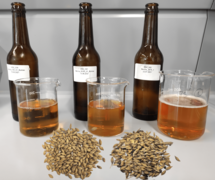New Paper on Alternaria Mycotoxins
Our recent publication sheds light on the presence of Alternaria toxins in beer as well as the effectiveness of optical sorting methods in reducing their concentration. Alternaria is a type of mold that infests large varieties of crops including barley, which often leads to a black coloration of the barley grains. Toxins produced by the fungi are commonly found in beer, stemming from the malt. Optical sorting methods might be applied to sort out dark barley grains before the brewing process and, thereby, reduce the amount of toxins in the beer.
In our study, brewing experiments with different ratios of clean and black grains, obtained by optical sorting, were conducted together with the Chair of Brewing and Beverage Technology. It was found that tenuazonic acid was the only toxin in this study to migrate into the beer, while other Alternaria toxins are mainly found in the spent grains. Additionally, optical sorting was proven to be a successful tool to reduce the mycotoxin concentration in the starting material, but only in case the black coloration of the grains is a result of Alternaria infection and not of weather staining or other black molds, which can be checked by DNA analysis.
Picture: Beer brewed with different ratios of dark colored barley was analyzed on its Alternaria mycotoxin content.
